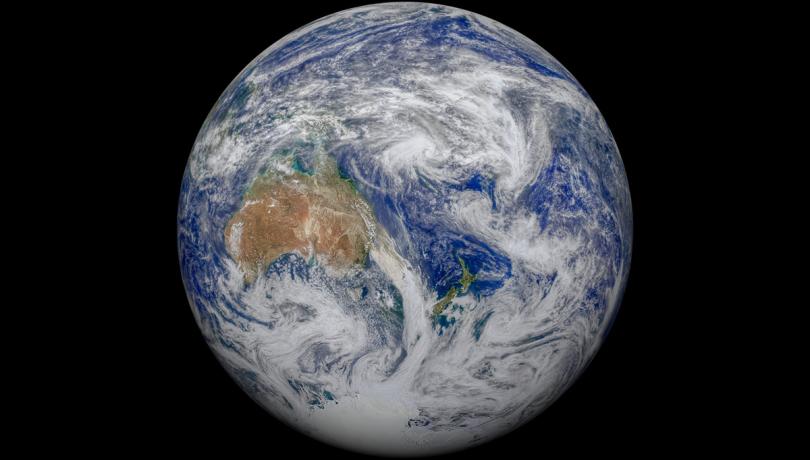A collaborative international study with participation of the ICM-CSIC uses innovative machine learning models to reduce uncertainty in climate projections and reshape our understanding of ocean-atmosphere sulfur cycling.

Ocean emissions of dimethyl sulfide (DMS)—a key component of Earth’s natural sulfur cycle—are expected to increase over the coming decades, even as DMS concentrations in the ocean itself decline, according to a new study published in the Proceedings of the National Academy of Sciences (PNAS). The study represents a major advance in climate modeling and has significant implications for quantifying DMS's future effect on climate regulation.
DMS, a sulfur-containing gas produced by plankton, plays a central role in the formation of atmospheric aerosols. These aerosols reflect sunlight and help form clouds, processes that exert a cooling effect on the Earth’s climate. While DMS is the largest natural source of sulfur in the atmosphere, its future behavior under climate change scenarios has remained poorly constrained.
Previous projections of DMS emissions have relied heavily on mechanistic numerical models of ocean ecosystems. However, these models vary significantly in their outputs: some project increases in oceanic DMS concentrations, while others predict decreases, resulting in substantial uncertainty. The latest Intergovernmental Panel on Climate Change (IPCC) report (AR6) highlighted this uncertainty, citing it as a key limitation in quantifying feedbacks between ocean biology and climate.
In the new study, an international team led by the Indian Institute of Tropical Meteorology (IITM) combined numerical ecosystem models with cutting-edge machine learning techniques trained on a global database of nearly 900,000 DMS measurements. This hybrid approach allowed researchers to improve the accuracy of future DMS concentration and emission estimates across eight different Earth system models.
“Our work shows that, even though DMS concentrations in surface waters are projected to decline slightly due to climate warming, rising sea surface temperatures and increasing wind speeds will more than compensate for this decrease, leading to a net increase in atmospheric DMS emissions,” says Rafel Simó, marine biogeochemist at the ICM-CSIC and co-author of the study.
This finding contradicts previous assumptions—reflected in IPCC projections—that warming would reduce DMS emissions, thereby weakening this natural cooling mechanism. Instead, the new results suggest that natural sulfur emissions may partially offset some future warming, especially as human-made sulfur emissions continue to decline due to stricter air quality regulations.
“The relative importance of natural marine emissions will grow as anthropogenic sources decline,” Simó adds. “This makes natural emissions even more critical to refine our understanding of marine biogeochemical feedbacks to climate.”
The research also marks the first time that machine learning has been applied at a global scale to project future DMS emissions in combination with mechanistic models.
“What we’ve done is bring together the strengths of two modeling approaches,” explains Martí Galí (ICM-CSIC), co-author of the study. “Mechanistic models simulate ecosystem processes, but machine learning allows us to ‘learn’ from vast observational datasets and correct for biases. The result is a more robust prediction of future trends.”
By dramatically narrowing the range of uncertainty, the study provides a valuable new reference dataset for climate modelers and atmospheric chemists. According to Galí, these findings may directly influence how future IPCC reports estimate the impact of natural aerosols on the Earth’s radiation balance.
“Climate feedbacks involving aerosols are one of the largest sources of uncertainty in projections of future climate,” he says. “Our approach can be extended to other natural aerosol precursors as well, helping to improve climate models more broadly.”
The ICM-CSIC’s role in the study focused on advising on the biogeochemical aspects of DMS cycling and contributing to the analysis and writing of the paper. “We’ve been studying the marine sulfur cycle for years, and this was a great opportunity to put that expertise to work in a collaborative, international project,” Galí notes.
Looking ahead, the research team plans to apply similar modeling techniques to other marine trace gases, such as methanethiol (methyl mercaptan), a lesser-known sulfur compound also produced by plankton. “Methanethiol is like DMS’s chemical cousin,” Galí explains.
“It has similar cooling effects on the climate, but it’s less well understood. Our current challenge is to collect enough measurements to apply machine learning techniques to it, while deepening our understanding of the processes that regulate its concentration.”
As global efforts intensify to better predict and mitigate climate change, studies like this one underscore the importance of understanding not just carbon dioxide, but also the complex web of natural feedbacks involving the ocean and atmosphere.